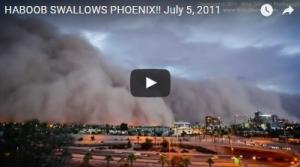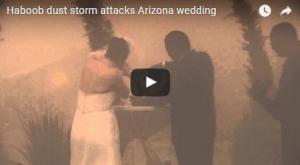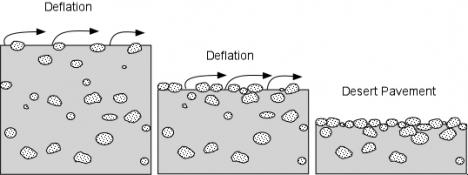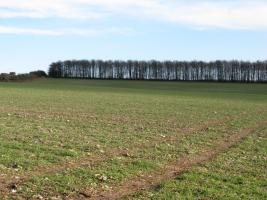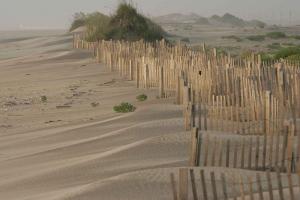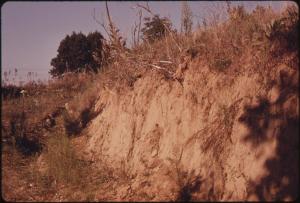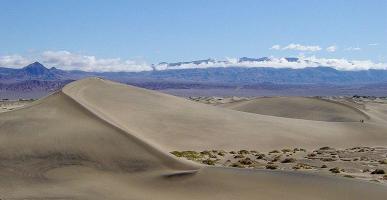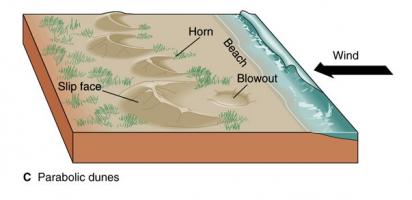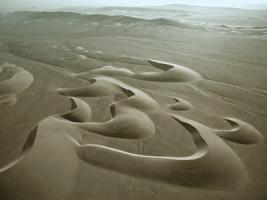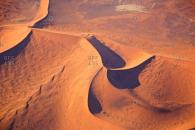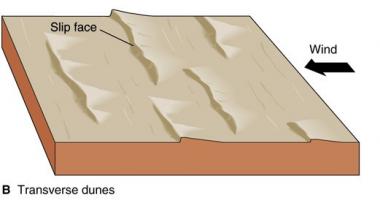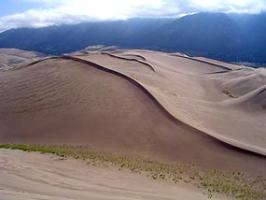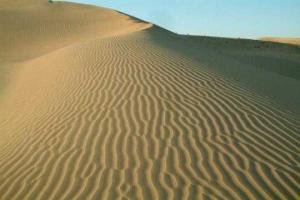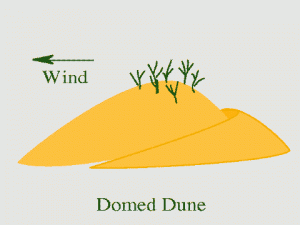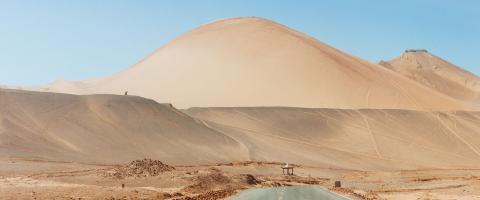Wind Erosion
Daily Dose of Destruction
Like all erosive processes, wind erosion is very powerful and given enough time, very destructive. When the wind blows across loose sediment, it removes small particles like clay, silt, and sand, leaving the heavier sediment behind. The ground actually gets lower over time and those heavier sediments become quite firm in the ground. This process of removing lighter sediment is called deflation. The harder ground left behind, can be so firm that roads can be built on it and is called desert pavement. As the wind blows sediments around, the sediments strike other sediment chipping off pieces of larger rocks. This process of abrasion can smooth rock surfaces and actually polish some of them.
|
|
Some sediment that is blown by the wind, rolls along the ground, like larger grains of sand because it is too heavy for the wind to pick it up, in a process called creep. If particles like lighter sand and silt, get blown into the air but are too heavy to be suspended there, they fall back to the ground in another process called saltation. Some sediment like clay is so light that they fly in the wind and we call that suspension. Wind can carry clay and silt-sized sediment miles away and into the atmosphere. As particles creep along the ground and jump into the air, they knock other sediment loose and it too begins to move in the direction of the wind. These processes can be so persistent and effective that they can create a sandstorm called a haboob. Haboobs are very common in Arizona during the monsoon season. Wind-blown sediments are great eroders and weatherers.
In order to combat wind erosion in agricultural areas, farmers and ranchers will plant windbreaks around their fields to try and slow the wind down. To keep beaches from eroding in the wind, they too use windbreak fences and plant grasses that hold the sand in place slowing the erosion down.
When the wind loses its energy the sediment load stops moving and gets deposited on the ground. Sometimes over many years, fine-grained windblown sediment like silt and clay have piled up in huge layers that are called loess. Many naturally fertile fields are fertile, because of this loess that is made up of topsoil from another area.
The wind builds sand dunes. Sand dunes actually migrate over time, changing their locations in a process called dune migration. There are many prehistoric rock formations that are actually ancient sand dunes. Sand dunes start when windblown sand runs into something that is blocking sediment transport, like a shrub, a rock, or the side of a hill. These sand dunes can grow very large because the higher they grow the more sediment can become trapped by them. You can tell the general wind direction, even ancient wind direction by studying and understanding sand dunes. The side facing the wind has a gentle slope. Dunes move away from the direction of the wind. As a dune gets higher, its angle of repose will cause it to collapse. We call the steeper face of the sand dune, the slip face.
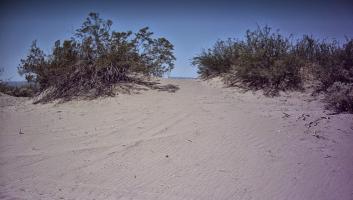
|
|
There are several types of sand dunes.
- Barchan dunes: Crescent-shaped. Has "horns" that point in the direction the wind is blowing. The slip face points away from the wind. It can get as tall as 9-30 meters high. It can migrate up to about 100 meters each year. They can be seen on Mars as well.
- Parabolic dunes: Also crescent-shaped but in the opposite direction. The wind is blowing into the crescent and the slip face is on the outside of the "horns." Vegetation holds the "horns" in place. There is one parabolic dune that has a 12 km "horn." Don't grow very tall. Maybe 10 to 20 meters.
- Star dunes: Has three or more slip faces. It has three or more arms that move out from the center of the dune. It can grow very tall. Some have reached 500 meters.
- Transverse dunes: Very long. Sit at right angles to the direction of the prevailing wind. Formed in lines. Slip face is on the leeward side. Most beach dunes are transverse.
- Longitudinal Dune: Sits parallel to the prevailing wind. Tens of meters high. Some have been known to grow up to 100 km long.
- Dome dunes: Looks like a dome with a lot of crests. No distinctive slip face.
One of the coolest places with sand dunes to go visit is the Great Sand Dunes National Park in Southern Colorado. Below is the Great Sand Dunes National park website. Check out the animation video about how the national park was formed. There is an awesome geologic story to the park.
In the following lab, you are going to take your new knowledge of sand dunes and model their shapes and demonstrate the wind direction. You know that you miss playing in the sand, so here is your chance to relive your childhood.
This lab is open to everybody. Bring some sand and have some fun. Sand Dune Lab










